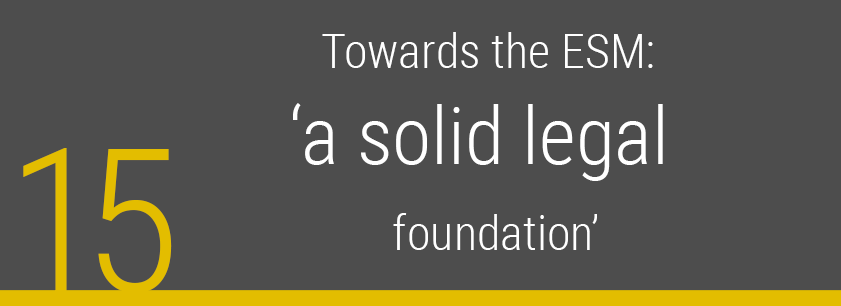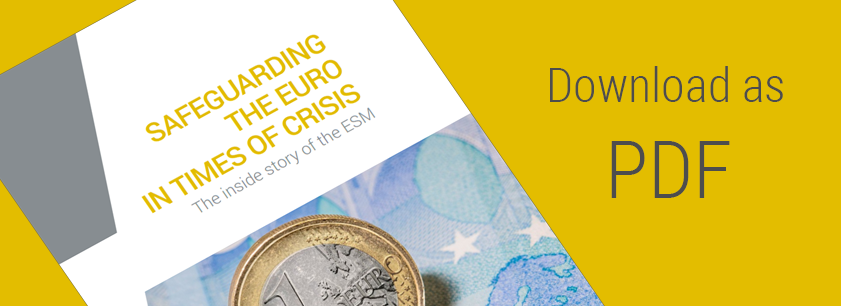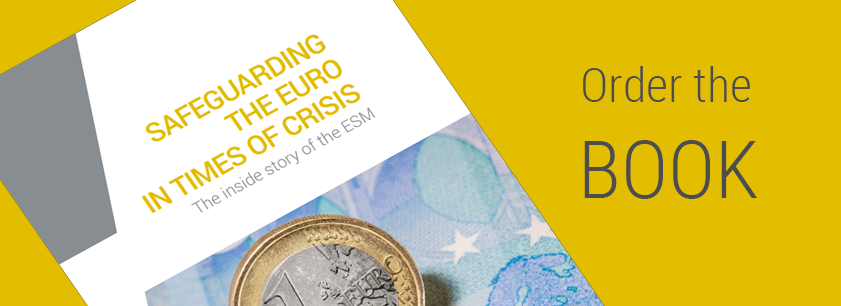14. Scaling up the fund: the ‘save Europe’ call
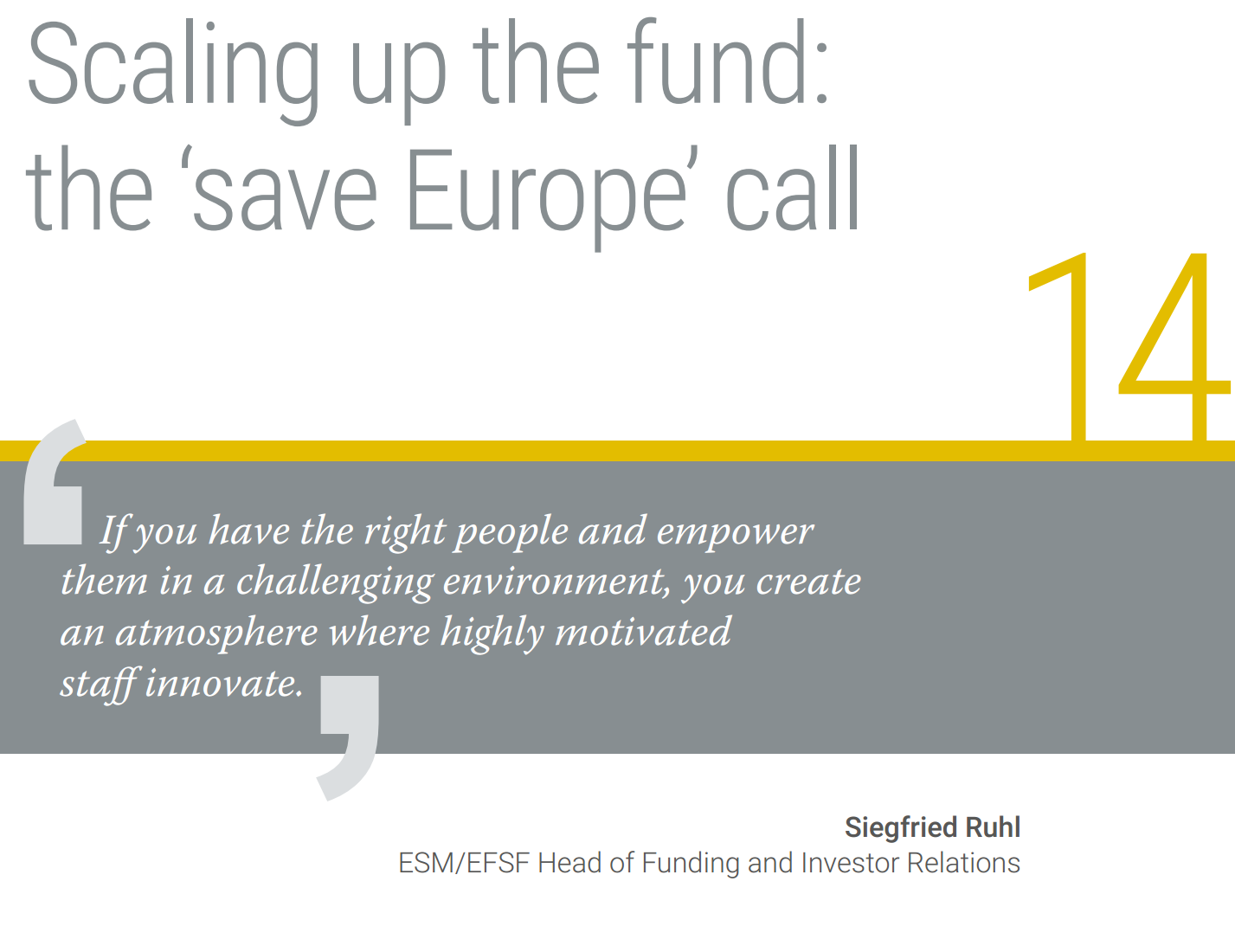
Programmes for Ireland and Portugal sent a signal that the new rescue fund would have to scale up. Chief Economist Strauch said the lending and funding structure devised in the beginning was an auspicious start. The expansion started a bigger discussion about what changes might be needed for the long run. The EFSF’s original plan was to raise money on a per-disbursement basis, but over time it might need to shift its strategy towards a more consistent relationship with the markets.
Chief Finance Officer Frankel said the EFSF knew the overwhelming demand for its first bond offering would not be a regular occurrence. Still, that initial performance was a great reassurance as the team worked to improve the temporary firewall.
‘It was quite a busy time for 11 people!’ he said. ‘We were satisfied that the mechanism worked and could be used again, even if we knew that the nine-times oversubscription would not happen again.’
As concerns grew that other countries might also need help, thoughts turned increasingly to revamping the initial lending and funding structure, Strauch said. ‘We started seeing that the initial financing framework and resources envisaged for the EFSF might not be sufficient and might have to be changed – particularly in case other countries were to follow.’
Because the EFSF’s debut transaction had a 5-year maturity[1], it probably wasn’t a good idea to go back to the same segment of the market right away. So the EFSF began considering shorter or longer: a 1-year, 2-year, 3-year, or 10-year issue. The timing was tight, but the EFSF was ready to fund its share of the €78 billion programme once the Eurogroup agreed to provide assistance, on 16 May 2011. The EFSF’s contribution was €26 billion and the first disbursement was due less than a month later. The EFSF went to the market for the second time on 15 June 2011, with a €5 billion 10-year bond. With this issue, the ‘temporary’ EFSF could now be counted in decades.
Overall, the second sale succeeded, but on a more down-to-earth scale than its predecessor. The order book came in around €8 billion with participation from nearly 100 institutional investors[2], about a third of which were central banks and sovereign wealth funds. The EFSF was off to a great start, but, over time, the short turnarounds would become increasingly difficult. At times, ‘it was difficult to raise the money and the price we had to pay was relatively high,’ Frankel said.
Strategy discussions focused on long-term funding. ‘It was terrific that the first bond sale had been such a success, but the second, third, and fourth ones needed to work too,’ said Weinberg, the German Finance Agency expert who led the initial EFSF funding programme. The new firewall and its eventual permanent successor had to figure out in the short run, where to approach the market next, and, in the long run, how to establish the right reputation with the kinds of investors the euro area needed.
To some, the Luxembourg arrangements seemed a little, well, odd. Jürgen Klaus, a long-time trader who became a funding officer at the rescue fund, said he remembered thinking to himself: ‘What is this private company, this société anonyme, that is located next to a shopping mall in Luxembourg?’
At first, those assigned to the EFSF within the German Finance Agency kept a professional distance from their colleagues. The agency created a separate division for its EFSF office to make sure everything was in order.
‘We analysed whether a separation from the activities executed for Germany was necessary from a compliance perspective and came to the conclusion that it was necessary because of one aspect,’ Weinberg said. After the EFSF began to issue in January 2011, ‘every launch of a bond transaction required some investments. Because the colleague who was responsible for EFSF investments needed to be able to buy German government securities, we had to put up a Chinese wall between him and the German government securities traders.’
In the beginning, EFSF borrowing was ‘not very flexible. We stuck to certain maturities in the first few issues. We were a very small team,’ said Silke Weiss, another funding officer. And the German agency naturally operated with a domestic, not an international, outlook, unlike the EFSF, where English was the working language.
When Dassyras joined the EFSF team from Greece in June 2011, it was the first time the German Finance Agency had hired someone who didn’t speak German. ‘Since I could speak English, I was asked if I could help him,’ Weiss recalled. ‘I bought him a Greek-German dictionary to get him started.’
The EFSF’s debt management pioneers worked late, ordered in pizza when needed, and tried hard to handle all the demands of a two-location start-up. ‘It was maybe not the ideal set-up, but in the beginning it was easy enough to communicate,’ Frankel said. ‘There were not so many transactions, so it was not so much of a burden to go to Frankfurt for the transactions at the start.’
As the pace picked up, the outsourcing period wound down and the whole operation moved to Luxembourg. Weiss later transferred permanently to the ESM from the German Finance Agency. ‘It felt like the rescue funds were something that would be with us for a long time,’ she said.
Weiss said the need to consolidate became evident as the EFSF required access to more maturities and a generally more flexible approach, so the start-up funding team began designing a system that could grow with the institution. ‘Everything in Luxembourg was still in the making so we had to coordinate somehow with them, while being in Frankfurt.’
The team set up a fixed timeslot for a conference call, Mondays at 17.00, lasting anywhere from 15 minutes to an hour. ‘We called it “the save Europe call,”’ Weiss said. She recalled the small core in Frankfurt coordinating with Luxembourg, and sometimes the European Commission. ‘We talked about the market, upcoming transactions, and the sequencing of the transactions of the European Commission’s emergency fund, the EFSM, and those of the EFSF.’
João Gião, a former ESM/EFSF legal officer, who joined from the Portuguese securities regulator, said the public service aspect made the long hours tolerable and created a feeling of belonging. ‘When I moved here, I certainly thought I was on a mission. You kind of feel a special sense of reward,’ Gião said. ‘When you have to work late, you do it not with the goal of getting a bonus at the end of the year, but because you are trying to solve a problem that will improve lives, or at least make them less hard.’
In May 2012, the funding team started commuting, spending Monday to Wednesday in Luxembourg and flying back to Frankfurt to finish the working week. By then, the original four-person German finance group funding team had been joined by an experienced trader, a senior business analyst, and an information technology specialist who would make sure the EFSF could work smoothly with the finance agency systems.
Klaus thought of it as the ‘Breakfast Club’: Dassyras, Gerhard Hannoschöck, Klaus, Thomas Ritter, Ruhl, and Weiss. Ruhl, who had become head of the EFSF front office division and was Weinberg’s right-hand man, remembers 12- and 14-hour days that ended up in a hotel across the street from the office. Weiss said that the 18.55 Wednesday flight was her weekly commuting milestone.
Over time, being on-site gained more importance as member states began requesting assistance and the EFSF developed new tools beyond basic aid loans. Funding Officer Rodriguez said there were ‘intense negotiations’ to get staff to commit to relocating during this period, which eventually succeeded, even if some staff kept up a weekend commute afterwards. ‘It was not easy for them or for us, but it got progressively better in terms of settling them definitively in the institution.’
As the relocation to Luxembourg approached, Klaus had his turn to see the market in a new way. He was called on to investigate what physical set-up the rescue fund could use for conducting transactions, down to picking out the furniture. He sought out his old private sector colleagues, but not for what they expected. ‘I visited trading floors in Frankfurt – I went to my former employer in search of practical info,’ he said. ‘To my former colleagues’ surprise, I showed up asking to speak to the facility manager. They would say “Really?” and I would say “Really. I would like to have a look at what kind of desks you have.”’
Later on, the middle and back office team worked together to organise the clearing and settlement of the ESM’s paid-in capital investments. While the team managing the capital executed such trades, the mechanics were handled by a US bank, and, when this was being set up in 2012, there was much discussion about whether or not the euro area’s firewall should depend on firms from outside the area to clear its transactions.
But the core goal was to make sure the EFSF and ESM could function when the markets themselves weren’t working correctly, which meant using the best providers for the job. Those early days were marked by many calls with Germany’s Bundesbank, the ECB, and a European international central securities depository providing post-trade services to arrange all of the necessary payment connections.
As the EFSF grew into the ESM, it became more important for all of its staff to be under the same roof. For Weinberg, who chose to stay at the German Finance Agency, this meant making sure his team was ready to take its data, technology systems, and team spirit to their permanent home. ‘We supported them as much as we could at that point in time,’ Weinberg said. ‘It was important for me personally that they could be transferred to Luxembourg as a whole group.’
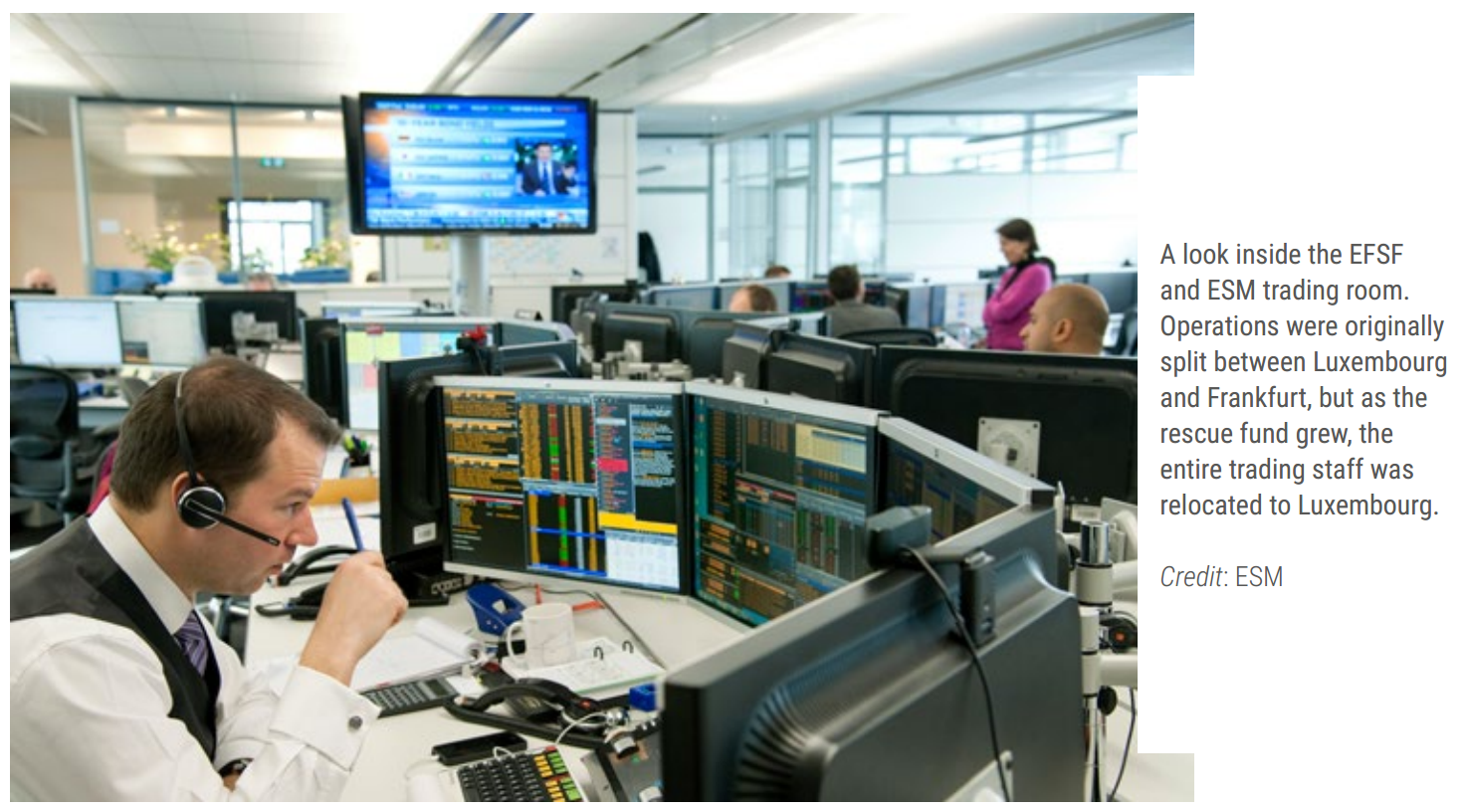
The ESM took over the contracts of the funding team in January 2013, ending the formal link to the German Finance Agency. Since then, the funding team has more than doubled in size, and specialists in investor relations have been added. The focus has shifted to how to help the institution mature now that the pressing needs of the early days have ceded ground to new pressures to develop more versatile strategies and analytical products. Still, the core of the team has been the veterans who were present from the start. In the end, the ESM was able to import its entire team from the German agency, allowing the firewall to grow without losing the critical knowledge gained in its first two years.
‘I have never experienced a team spirit like the one here in the German Finance Agency’s EFSF team,’ Weinberg said. ‘I had a feeling of the flow, like a runner’s high. If you are running along and are lucky you get into the flow. You feel that everything is moving effortlessly, and it gives you such a sense of satisfaction.’
Continue reading
[1] EFSF (2011), ‘EFSF places €5 billion bond in support of Portugal’, Press release, 15 June 2011. https://www.esm.europa.eu/press-releases/efsf-places-%E2%82%AC5-billion-bond-support-portugal
[2] Ibid.
